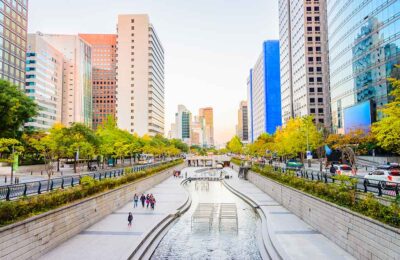Overcrowding, pollution, crime and less social support in urbanized areas has led to an increase in mental disorders. It is now becoming a huge challenge because more and more people are moving into urban areas. Building sustainable and healthy cities are essential for the well-being of urban residents.
Studies have shown that living in natural environments is related to improved mental health and lower mortality.
The COVID-19 pandemic has highlighted the lack of access to natural spaces in cities, especially in low-income areas.
Importance of blue spaces in urban areas
Globally, about 87% of the wetlands have disappeared in the past 300 years due to infrastructural developments and industry. It is essential to protect the natural environment in all urban planning projects from pollution and unsustainable practices.
Blue spaces are any visible water that is both natural and man-made. From rivers and lakes to fountains and pools, blue spaces in the urban environment not just offer a physical attraction to a city but also improves the mental health of its residents.
Urban environments play an important role in enhancing human health and wellbeing. Positive benefits of health and happiness are linked with the proximity to water. Less air pollution and exposure to more sunlight are some of the positive environmental factors.
On the other hand, people are more physically active with an increase in walking and cycling in areas close to water. Compared to green spaces, water has a more psychological restorative effect that leads to positive moods and a decrease in stress.

Offers people a variety of features
Artificial water features installed in cities can bring huge benefits to urban residents who have no immediate access to lakes, rivers or the sea.
Waterfalls, pools, water tunnels, water fountain, parks and playgrounds are some of the features that could help with positive mental health benefits and improving the social life of urban residents.
Promotes social inclusion
Water in public spaces is not just a decorative element but also used as a functional feature in urban areas. It enhances social cohesion by acting as a meeting and gathering space for people in public spaces.
Builds healthier and resilient cities
Artificial ponds, lakes, wetlands and rivers act as a resilient feature in cities and help in storing rainwater and tackling flood-related issues. Water helps in reducing the urban heat island effect and improving the surrounding air quality. This makes the city more livable and healthier for citizens.
Reduces summer heat
A well-managed blue and green space invites more people to spend time in cities. Water features act as a cooling urban element in humid regions, summer months and heatwaves. It can provide people with better urban environmental conditions during the harsh climate.
Improves green-blue infrastructure for low-income people
Incorporating water elements along with green spaces while planning urban areas especially benefits low-income people who lack private gardens. But it is important to avoid a rise in property values when improving access to green-blue spaces for low-income residents.
Promotes sustainable spatial planning
One way to include more blue spaces in an urban area is during the early stages of spatial planning. Safe, accessible and clean blue spaces encourage more people to spend in the urban environment. Blue spaces are key in achieving sustainable urban development.
Planning for cities with water not only improves the health of urban dwellers but also builds a resilient city that tackles climate change factors.

Benefits of blue and green spaces in cities
- Creates a lively and healthy city
- Improves mental and physical health and well-being of residents
- Provides a sustainable urban development
- Supports other facilities such as cycling and place for recreation and entertainment
- Acts a resilient infrastructure for climate change factors, flooding and drought
- Cools the urban environment by reducing the urban heat island effect
- Captures carbon
- Enhances air quality
- Enhances biodiversity and ecosystem
A healthy city creates healthy citizens.

